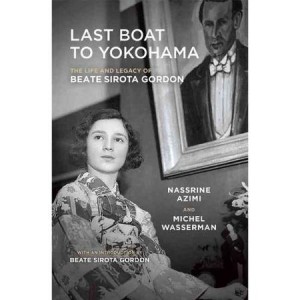In 2013, when it was announced that Beate Sirota Gordon, contributor to the Japanese Constitution, had passed away, there was scant information available about this singular woman’s life. I detailed my struggle getting my hands the English translation of her memoir in this post. But now, I’m excited to report, there’s not just one book on Beate Sirota Gordon, now there’s two! TWO! (I’m not even being sarcastic!) Publishing this month, we have a biography written by Nassrine Azimi and Michel Wasserman. As someone who devoured Beate’s memoir, I was eager to see what new information this book reveals.
In Last Boat to Yokohama, authors Nassrine Azimi and Michael Wasserman, firmly anchor Beate’s story within events of World War II and the years leading up to it. We know the Third Reich had grand plans for conquering Europe, but how did Japan fit into their plans? Last Boat to Yokohama explains how Germany had been a long time ally of Japan–in fact, many of its institutions had been based of Germany’s (Remember how Raichō Hiratsuka’s father was fluent in German?). It also details how Nazi Germany pushed their anti-semitic policies in Japan. However, since Japan did not share Nazi Germany’s prejudices, the popular Jewish musicians were protected—for a time. The authors detail the deteriorating situation from Beate’s father, Leo Sirota, from losing his job at the Imperial Academy to the constant surveillance of the Japanese police.
In the movie Schindler’s List, there’s a scene where a group of women argue against rumors that the Nazi’s have created death camps. The Germans would never do such a thing, they argue. Likewise, Leo Sirota believed that Japan would never go to war with the United States. That’s why in September of 1941, when the Sirotas visit Beate in America, they end up returning to Japan in November 1941. The Japanese would attack Pearl Harbor a few weeks later. The Sirotas were on the last boat to Yokohama.
But this book delivers more than just historical context, it’s also a collection of various writings–and not just from Beate. We hear directly from Beate’s mother Augustine from a draft of her own autobiography. There is a speech on Beate’s legacy from her daughter, Nicole. Geoffrey, Beate’s son, writes an incredibly beautiful and intimate eulogy, the story of Beate’s life, written in the 2nd person. My favorite line: “You have more years than there are keys on the piano.” (There are 88 keys on a piano and Beate passed away at the age of 89. ) There are also selected sections from both the Meiji Constitution and the 1946 Constitution. The authors have allowed readers, themselves, to compare and contrast these two constitutions. For those familiar with the constitution of the United States, you can see to what extent it influenced the Japanese constitution. All these various writings allow readers to experience Beate’s life and legacy through multiple angles and perspectives.
Another strength of this book is that it is co-written by Nassrine Azimi, the co-founder of the Green Legacy Hiroshima and the Hiroshima Office of the United Nations Institute for Training and Research (UNITAR). Azimi reminds the reader that Beate’s life isn’t just an inspirational story, but a case study in the importance of women’s contributions in rebuilding a peaceful society after the devastating effects of war. And not just of the wars of the past, but in the wars of the present and future. She includes Beate’s preface to Post-Conflict Resolution where Beate forcefully argues that any peace agreement should be contingent on the inclusion of women’s rights. Beate also argues that nations around the world would be much more prosperous and peaceful if national expenditures were devoted to the economy instead of the military.
Finally, this book shares a facet of Beate’s life that she could not share herself: her final days. Her daughter, Nicole, describes how during the last weeks of her life, she still granted an interview to a Japanese newspaper, advocating for the preservation of the Japanese constitution and its dedication to peace.
The Last Boat to Yokohama is a necessary addition to myriad of books written about World War II. It is complementary to Beate Sirota Gordon’s memoir The Only Woman in the Room and deserves a place in any school, public or personal library.
[AMAZONPRODUCTS asin=”1941110185″]

Thank you Anna Lee, for this brilliant review. Beate Sirota Gordon was indeed a remarkable woman, whose life is a huge inspiration. As Yoko Ono put it, “All of us have a lot to learn from Beate Gordon–a woman with the courage to match her convictions.” We will be holding two launch events in the NYC area in mid-May: May 19 at Cornelia Street Cafe (details at: http://bit.ly/1IppMnR) and May 20 at the Rubin Museum (http://bit.ly/1G2YBum). I encourage you and all of your readers to attend and discover more about this brilliant woman.